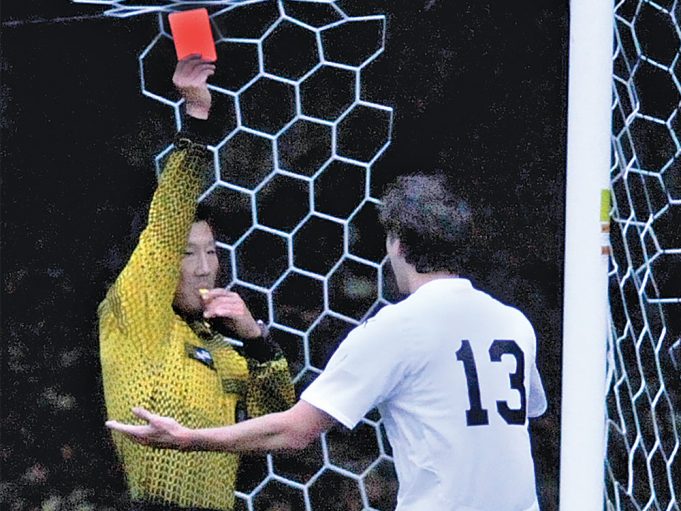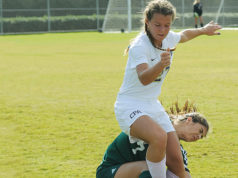A few years ago, U.S. Soccer made available to all referees a very small clip titled, “Ask, Tell, Dismiss.” Michael Kennedy, former FIFA referee, is the narrator. He and other top-notch referees narrate a good number of clips that are available for all to see on the U.S. Soccer website. Annual clinics offered in many states would be on the right track if some of these clips were discussed. The information included and the valuable active participation the instructor can get out of attendees would be helpful to a referee crew on a Saturday afternoon where the real test occurs.
The clip mentioned by name above deals with dissent by team officials from the “bench area.” In many of our games, the technical or team area is marked. If it is not marked, some referees use cones to show the technical area. What can the referee say if a coach or player does not stay within that area? What if raised voices, dissent and abusive language are used to intimidate the referee crew? The video clip is clear: you ask, you tell, and finally dismiss if behavior is not corrected. But do we adhere to that practice on a Saturday afternoon? And is dissent only coming from the bench?
Can the referee do something to prevent dissent from escalating?
A friend of mine sent me a problem he encountered during a showcase tournament. “There were two U-16 girls’ teams, one from California, the other from Washington. The California team was physical, while the Washington team was a bit passive. However, neither team held back any comments to the referee nor to each other. During the first half, there was a clean tackle on the ball. Unfortunately, a California girl went flying but I could not whistle the play. Of course, I heard ‘tackle from behind’ loudly and repeatedly from the coach. A few minutes later, a California defender committed a foul and kicked the ball about 15 yards away from the spot of the foul. I brought out my yellow card for her. The coach yelled, ‘This is not about you, ref. This is about the girls.’ On the restart, another defender stood 2 yards from the ball. I asked her to move back but she refused. I repeated my request, but she stood her ground. As I’ve been taught in our clinics, a caution was necessary. When a teammate asked, ‘Why did you get the yellow?’ the offending girl commented, ‘Because the ref is too lazy to march off the 10 yards.’ I went over in my mind what was just said and realized this is a good case of dissent directed at me. A second yellow was shown and then a red. Of course, her coach let everyone know how terribly his team was being treated.”
The two youth soccer teams mentioned could be any team in our country and the referees in this crew could be any of us on a Saturday afternoon. Has dissent by coaches and players gotten out of hand these last few years? Are the cautions for dissent starting to add up? Could the referee above have done something to stop the dissent before it escalated to a cautionable offense?
I recently participated in a NASO questionnaire that dealt with officiating. Data from this questionnaire will be available soon. While answering their questions, it got me thinking about how we handle dissent by players and coaching staff. Over the many games I have watched, officiated or assessed when a player crossed the line and a caution for dissent was needed, the dissent often started with the coaching staff crossing that “line” first, earlier in the game while referees, trying to be too friendly, chose not to stop the inappropriate behavior. Perhaps if we would look again at the U.S. Soccer’s Ask, Tell, Dismiss video and its message, we would not hear as much talking back to referees.
If the adults in the technical area are not being reprimanded for their outbursts, you can virtually guarantee the players will think it is acceptable to speak in any manner to the referee crew, and even to each other, during their game. In the above story, could the game have had a different outcome if the referee asked the coach after his first loud and repeated taunt to act appropriately? If so, would this be a message to the players that the referee was not going to put up with behavior that crosses the line? The coach’s second outburst, questioning the referee’s decision in an intimidating way, obviously crossed that line again. This would have been a very good time to tell the coach, “That’s it, no more!” If the players can’t see a message is being sent, then what would it take? In some cases, sadly, it would be a red card and a player sitting while their team plays short. But even then it might not be enough.
What's Your Call? Leave a Comment:
Note: This article is archival in nature. Rules, interpretations, mechanics, philosophies and other information may or may not be correct for the current year.
This article is the copyright of ©Referee Enterprises, Inc., and may not be republished in whole or in part online, in print or in any capacity without expressed written permission from Referee. The article is made available for educational use by individuals.
















